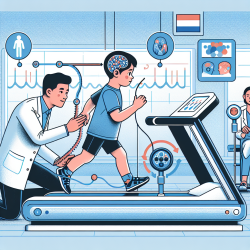Introduction to Transspinal Stimulation in Pediatric Therapy
In the realm of pediatric rehabilitation, innovative approaches are crucial for improving outcomes for children with spinal cord injuries (SCI). The recent study titled Priming Locomotor Training with Transspinal Stimulation in People with Spinal Cord Injury offers groundbreaking insights that can be leveraged to enhance therapeutic strategies. This study explores the synergistic effects of combining transspinal stimulation with locomotor training, presenting a novel approach to rehabilitation that may be particularly beneficial for children.
Understanding the Study's Findings
The research conducted by Skiadopoulos et al. (2023) investigates the potential of transspinal stimulation to enhance the effects of locomotor training. The study involved 45 individuals with chronic SCI undergoing 40 sessions of robotic gait training, primed with 30 Hz transspinal stimulation. The results demonstrated that transspinal stimulation significantly strengthens corticomotoneuronal connectivity and enhances dynamic neuromodulation, crucial for improving motor recovery.
Implications for Pediatric Practitioners
Pediatric practitioners can draw several key insights from this study to improve therapeutic outcomes:
- Enhanced Neuroplasticity: The combination of transspinal stimulation with locomotor training enhances neuroplasticity, which is vital for recovery in children with SCI. Practitioners should consider integrating these modalities to maximize therapeutic benefits.
- Non-Invasive Approach: Transspinal stimulation is non-invasive, making it a suitable option for children who may not tolerate invasive procedures. This approach can be easily implemented in clinical settings, providing a safe and effective treatment option.
- Customization of Therapy: The study highlights the importance of customizing therapy based on individual needs. Practitioners should adjust body weight support, treadmill speed, and leg guidance force according to each child's specific requirements to optimize outcomes.
Encouraging Further Research
While the study presents promising results, further research is essential to fully understand the long-term effects of transspinal stimulation in pediatric populations. Practitioners are encouraged to contribute to this growing field by conducting studies that explore the efficacy of these interventions in children with varying degrees of SCI.
Conclusion
The integration of transspinal stimulation with locomotor training represents a significant advancement in pediatric rehabilitation. By leveraging the findings of this study, practitioners can enhance therapeutic outcomes for children with SCI, fostering improved motor function and quality of life.
To read the original research paper, please follow this link: Priming locomotor training with transspinal stimulation in people with spinal cord injury: study protocol of a randomized clinical trial.










